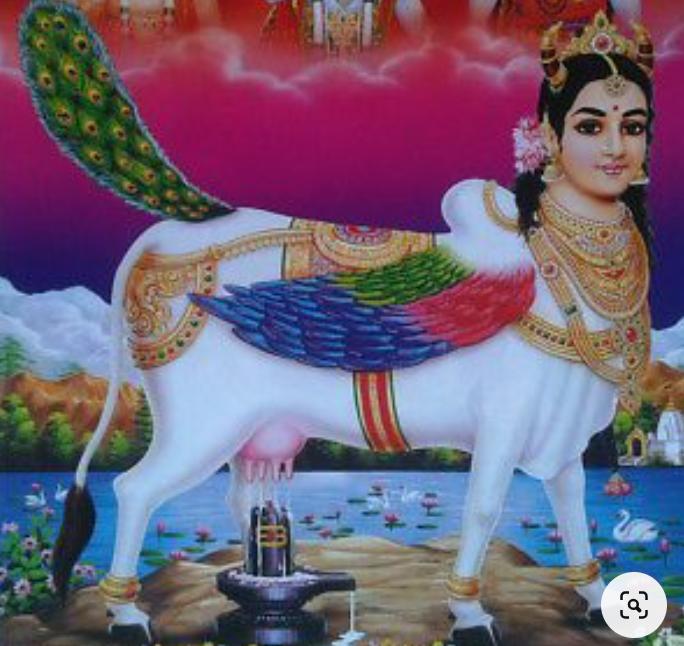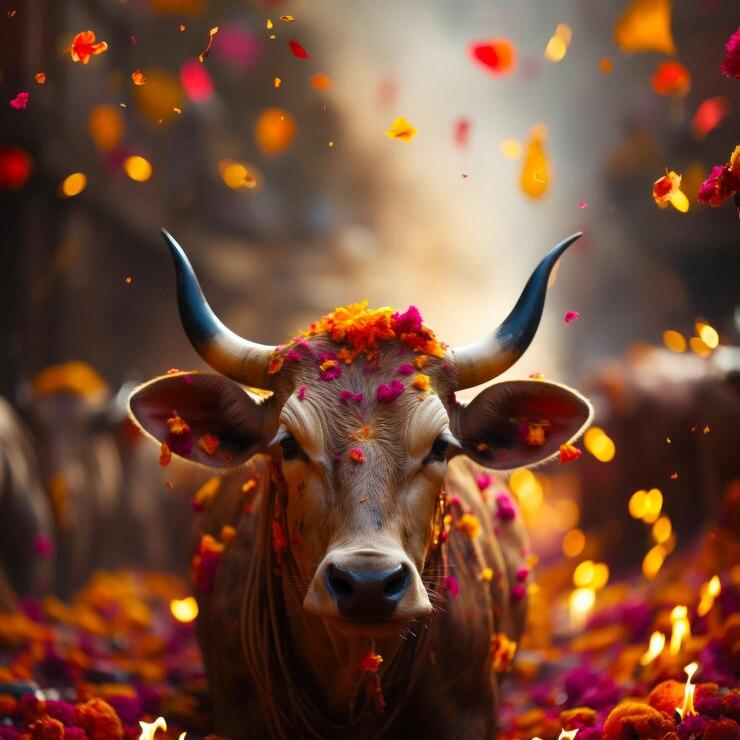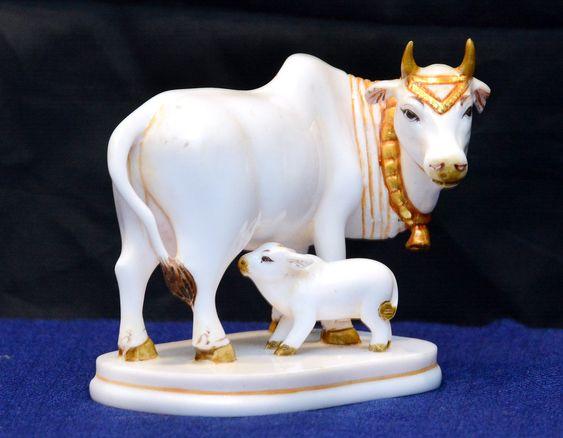



Table of Contents
- Highlights of Kamdhenu Cow
- Significance of Kamdhenu Cow In Hindu Mythology
- Significance of Parts of Kamadhenu cow
- Ideal Placement
- Best Room for Placement
- Preferred Materials for Kamdhenu Statue At Home
- Benefits of Keeping Kamdhenu Cow Statue
- Things to Not Do with Kamdhenu Cow Statue
- Faq's
According to Hindu mythology, the Kamdhenu, also known as Surabhi, Kamadugha, Kamaduh, and Savala, is a divine cow that originated during the churning of the cosmic ocean. This wish-granting cow is believed to possess extraordinary powers and is revered as a symbol of wealth, prosperity, and fertility.
In Vastu Shastra, the ancient Indian system of architecture, the placement of the Kamdhenu cow statue at home is considered highly auspicious and beneficial. In this article, we will explore the significance of Kamdhenu Cow as per Vastu principles and the correct placement procedure to maintain when keeping a Kamdhenu cow and calf statue at home.
Highlights of Kamdhenu Cow
Benefits of Kamdhenu Cow | Attracts health, wealth, prosperity, peace, success, and positivity. Helps ward off negativity. |
Directions to Place Cow | North-East, North, East, and South-West |
Best Rooms | Temple, living room, and near the entrance |
Best Materials | Silver, Brass, Copper, Marble, Stone, Ceramic, and Wood |
Size | Neither too big nor very small |
Significance of Kamdhenu Cow In Hindu Mythology
The Kamdhenu cow holds a big importance in Hindu mythology and is seen as a divine and revered figure. According to Hindu beliefs, Kamdhenu is considered the mother of all cows and is worshipped for being the harbinger of wealth, prosperity, and blessings. It is believed that Kamdhenu can fulfill any desires and wishes, apart from that it also holds a maternal role to several other divine beings within Hindu lore, such as Nandini, the wish-fulfilling cow, and Airavata, the celestial elephant mount of Indra.
As a Celestial entity, Kamdhenu displays divine grace with her unique form that shows a white cow adorned with ornate jewels, garlands, and a regal crown, along with human female features, bird wings, and a peacock's tail.

Kamdhenu- displays divine grace with her unique form Source: Pinterest
She is believed to reside in various realms, including Goloka, Patala, and the hermitages of sages, where she is revered and worshipped. Kamdhenu is not worshipped as an independent goddess but symbolises the sacredness of cows in Hinduism, representing purity, fertility, and compassion.
Cows, including Kamdhenu, are honored in Hindu culture for their provision of milk, ghee, and other essentials, associated with various deities like Krishna, Shiva, Lakshmi, and Saraswati.
 Cows, including Kamdhenu, are honored in Hindu culture for their provision of milk, ghee, and other essentials
Cows, including Kamdhenu, are honored in Hindu culture for their provision of milk, ghee, and other essentials
Significance of Parts of Kamadhenu cow
In order to grasp Kamdhenu's significance, we need to understand the importance of each of its parts first.
The Kamdhenu is a sum of its divine parts and each part is a guide to a specific aspect of life.
Hump: The hump represents prosperity.
Udder: Udder symbolizes abundance.
Head: The head facing inwards (of the house) shows the flow of positive energy into the home.
Tail: The tail pointing outwards (of the house) keeps the evil away.
Horns: Symbolise the Holy Trinity of Brahma, Vishnu, and Mahesh.
Eyes: The Sun and the Moon.
Shoulders: The shoulders represent the fire and Wind Gods, i.e., Agni and Vayu.
Legs: The 4 legs depict the four sacred Vedas and also the Himalayas.
Ideal Placement
The Ishan Kon, or the northeast direction of the house, is considered the most ideal location to keep the Kamdhenu cow statue. This is because the Ishan Kon is a sacred space reserved for the gods according to Hindu beliefs, and the Kamdhenu cow is seen as a vessel that carries all the deities within it.
If the northeast placement is not possible, the Kamdhenu cow statue can also be kept in the north or east parts of the house. The same Vastu guidelines apply when placing the statue at the workplace as well.
Also Read: 10 Feng Shui Tips To Remove Negative Energy From Home
Best Room for Placement
The worship room or pooja room, as commonly found in Hindu households, is considered the most auspicious place to keep the Kamdhenu cow statue. This sacred space, dedicated to daily worship and meditation, holds significant spiritual importance in Hindu traditions.
Placing the Kamdhenu cow statue in the worship room symbolises prosperity, abundance, and divine blessings, aligning with the reverence for the cow as a symbol of wealth and fulfillment in Hindu culture.
The presence of the Kamdhenu cow statue in the pooja room not only enhances the sanctity of the space but also signifies the embodiment of auspiciousness and positive energy within the home.
Alternatively, the entrance of the house is also a suitable location for the Kamdhenu cow statue. In many Indian homes, cows are traditionally kept at the entrance as a symbol of wealth, prosperity, and good fortune.
Placing the Kamdhenu cow statue at the entrance serves as a welcoming symbol of abundance and blessings, inviting prosperity and positive energy into the household. This placement not only honors the sacred significance of the Kamdhenu cow but also acts as a traditional gesture of respect and reverence towards wealth and well-being in Hindu culture.
Also Read: 6 Vastu Tips for Setting Up a Mandir at Home
Preferred Materials for Kamdhenu Statue At Home
 The ideal place to keep a white marble Kamdhenu statue is at the entrance of the home
The ideal place to keep a white marble Kamdhenu statue is at the entrance of the home
For those who can afford it, a silver Kamdhenu cow statue is highly recommended, especially for the worship room.
Brass, copper, marble, and ceramic are other suitable materials that can be used. The ideal place to keep a white marble statue is at the entrance of the home. The earthen cow statue is also considered equally good if placed in a Vastu-compliant manner.
Benefits of Keeping Kamdhenu Cow Statue
Keeping the Kamdhenu cow and calf statue at home is believed to bring numerous benefits, including:
- Improved health, wealth, and prosperity
- Increased peace, positivity, and overall well-being
- Fulfillment of wishes and desires
- Relief from mental stress, financial problems, and ill health
- Assistance for couples facing difficulties in having children
Things to Not Do with Kamdhenu Cow Statue
- Should not be kept in the bedroom or the bathroom
- The Kamdhenu statue should not be kept on the floor or in a dirty place
- Do not keep in a place where there is negative energy or a place which is easily accessible to children or pets
In conclusion, the Kamdhenu cow holds profound significance in Hindu mythology and Vastu Shastra, symbolizing wealth, prosperity, and divine blessings. Its placement in a home or workplace according to Vastu principles is believed to attract positive energies and foster overall well-being. By understanding the symbolism of each part of the Kamdhenu cow and adhering to the recommended placement guidelines, individuals can harness its auspicious qualities to enhance their lives.
Whether placed in the sacred space of a worship room or at the entrance of a house, the Kamdhenu cow statue serves as a powerful reminder of abundance, fertility, and spiritual grace. Embracing the wisdom of ancient traditions, incorporating the Kamdhenu cow into our living spaces can bring about positive transformations, fulfilling our deepest desires and ushering in a sense of harmony and prosperity.
explore further
Latest from Editorials
More from Publications
Resources
Dwello, for every home buyer, is a way to go from 'I feel' to 'I know', at no extra cost.




